Welcome, Today we are exploring Black Birds in Florida. As you know Florida, the Sunshine State, is not only known for its beautiful beaches and vibrant culture but also for its diverse avian population.
We will take a closer look at twenty remarkable black birds that call Florida home. From the majestic Anhinga to the European Starling, each of these avian residents contributes to the rich tapestry of Florida’s wildlife. Let’s dive into the fascinating world of these feathered creatures.
Types Of Black Birds In Flordia
1. ANHINGA
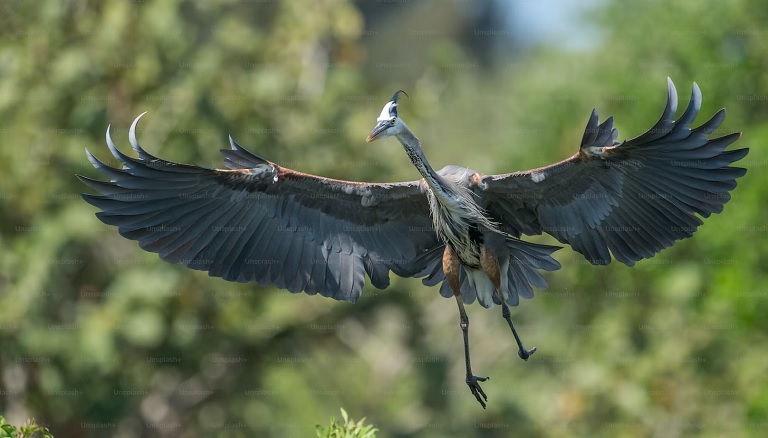
Scientific Name: Anhinga anhinga
- Size: 34-36 inches
- Weight: 2.5-4.2 pounds
- Wingspan: 43-47 inches
- Lifespan: 5-10 years
- Habitat: Freshwater lakes, swamps, and marshes
- Location: Throughout Florida
In the list of black birds in Florida, we have the first one is The Anhinga, often referred to as the “snakebird,” which possesses a distinctive appearance with its long, slender neck and sharp bill. These skilled divers are a common sight in Florida’s freshwater bodies. They use their sharp beaks to spear fish underwater, making them exceptional hunters.
Fun Fact:
Anhingas lack waterproof feathers, which aids in their underwater pursuits. After diving, they can be seen perched with their wings outstretched, drying them in the sun, a behavior known as “wing drying.”
2. DOUBLE-CRESTED CORMORANT
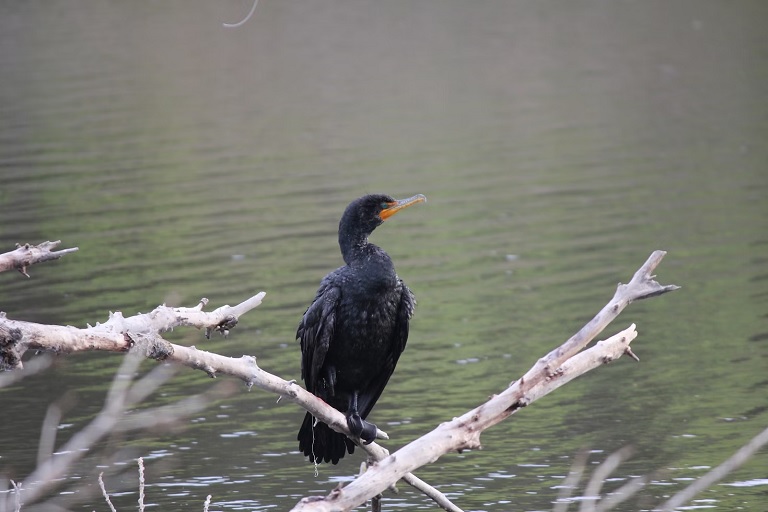
Scientific Name: Phalacrocorax auritus
- Size: 28-35 inches
- Weight: 2.6-5.5 pounds
- Wingspan: 45-48 inches
- Lifespan: 6-10 years
- Habitat: Coastal waters, lakes, and rivers
- Location: Florida’s coastal regions
The Double-crested Cormorant is a skilled fisher with a knack for underwater acrobatics. These birds are often seen diving beneath the water’s surface, propelled by their powerful webbed feet. Their distinctive double crests during the breeding season make them easily recognizable.
Fun Fact:
Cormorants have specialized preen glands that secrete oil to waterproof their feathers. This allows them to spend extended periods underwater in search of prey.
Related Article: Florida Birds Of Prey
3. MAGNIFICENT FRIGATEBIRD
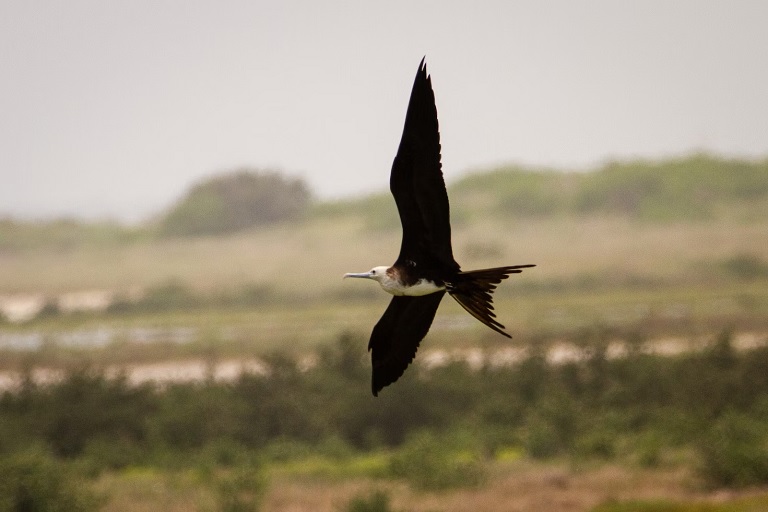
Scientific Name: Fregata magnificens
- Size: 35-45 inches
- Weight: 2.2-3.3 pounds
- Wingspan: 85-95 inches
- Lifespan: 15-25 years
- Habitat: Coastal areas and islands
- Location: Florida’s coastal regions and islands
The Magnificent Frigatebird is a true master of the skies, with its enormous wingspan and striking appearance. These pirates of the sky are known for their ability to steal food from other birds in mid-air. They are often seen soaring effortlessly over Florida’s coastal areas.
Fun Fact:
Frigatebirds are kleptoparasites, which means they steal food from other birds. They use their agility and speed to harass other birds until they regurgitate their meals, which the frigatebirds catch mid-air.
Must Explore Spotted Nutcracker
4. BLACK SKIMMER

Scientific Name: Rynchops niger
- Size: 16-20 inches
- Weight: 6.7-13.4 ounces
- Wingspan: 44-48 inches
- Lifespan: 20-30 years
- Habitat: Coastal beaches and sandbars
- Location: Florida’s coastal regions
The Black Skimmer is a master of precision when it comes to hunting. These striking birds have unique bills with lower mandibles longer than their upper mandibles, allowing them to skim the water’s surface for fish. Their distinctive black and orange bills make them easy to spot.
Fun Fact:
Black Skimmers are highly social birds and are often seen nesting in colonies. During the breeding season, their courtship displays, which involve aerial acrobatics, are a sight to behold.
You May Want to Read: All About Mourning Dove Eggs and Baby Mourning Doves
5. COMMON GALLINULE
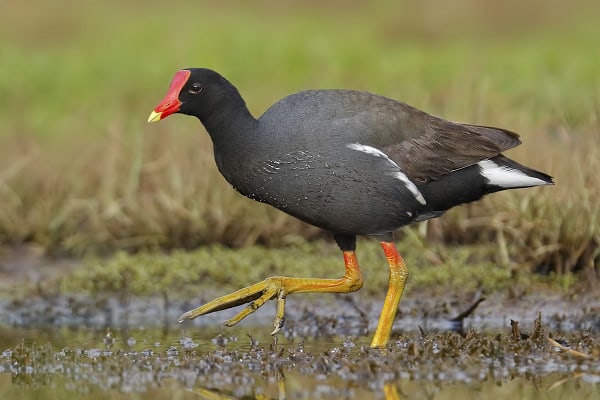
Scientific Name: Gallinula galeata
- Size: 12-15 inches
- Weight: 7-16 ounces
- Wingspan: 21-24 inches
- Lifespan: 3-5 years
- Habitat: Freshwater marshes and ponds
- Location: Throughout Florida
The Common Gallinule, formerly known as the Common Moorhen, is a bird of marshes and wetlands. With its vibrant red bill and shield, it stands out against the backdrop of Florida’s marshy landscapes. These birds are known for their distinctive “kek-kek” calls.
Fun Fact:
Common Gallinules have specialized toes that are equipped with long, slender toes, enabling them to walk on floating vegetation in search of food.
6. AMERICAN COOT
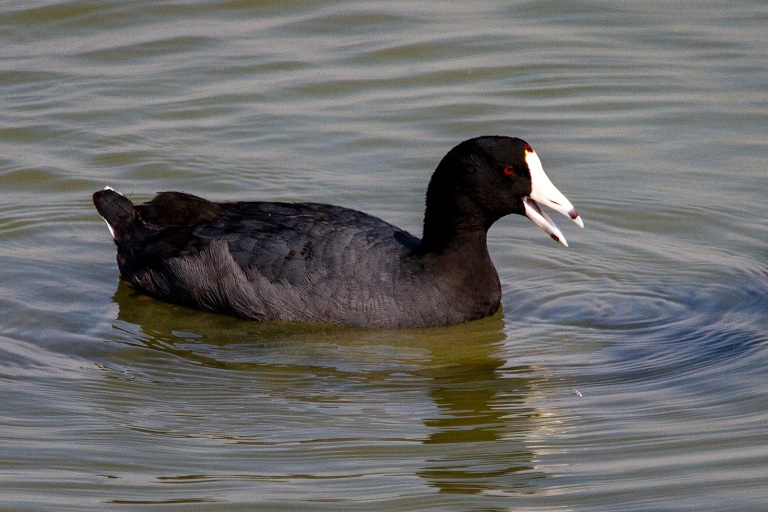
Scientific Name: Fulica americana
- Size: 13-15 inches
- Weight: 1.2-2.3 pounds
- Wingspan: 23-25 inches
- Lifespan: 3-5 years
- Habitat: Lakes, ponds, and marshes
- Location: Throughout Florida
The American Coot, with its distinctive white bill and bald forehead, is a common sight in Florida’s freshwater bodies. These birds are excellent swimmers and are often seen paddling gracefully across the water in search of aquatic vegetation.
Fun Fact:
Despite their aquatic prowess, American Coots build their nests on the ground, often hidden among vegetation near the water’s edge.
You may want to read 75+ Of The Best Penguin Names
7. BLACK VULTURE
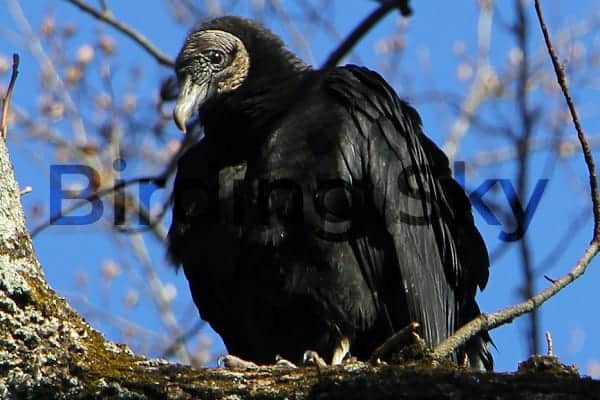
Scientific Name: Coragyps atratus
- Size: 24-27 inches
- Weight: 2.5-4.4 pounds
- Wingspan: 54-60 inches
- Lifespan: 10-15 years
- Habitat: Varied, including forests, urban areas, and coastlines
- Location: Throughout Florida
The Black Vulture, with its dark plumage and bare black head, plays a crucial role in Florida’s ecosystem as nature’s cleanup crew. These scavengers are often seen soaring high in the sky, searching for carrion to feast upon.
Fun Fact:
Black Vultures have a keen sense of smell, which is unusual for birds of prey. This olfactory ability helps them locate food, even from great distances.
8. AMERICAN CROW
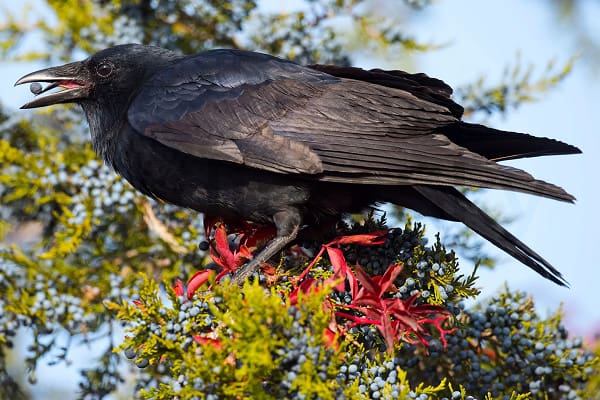
Scientific Name: Corvus brachyrhynchos
- Size: 16-21 inches
- Weight: 11-21 ounces
- Wingspan: 32-39 inches
- Lifespan: 7-8 years
- Habitat: Varied, including forests, cities, and farmlands
- Location: Throughout Florida
The American Crow is one of the most intelligent birds in the world. These jet-black birds are known for their adaptability and are often seen in both natural and urban environments across Florida.
Fun Fact:
American Crows are highly social birds and engage in complex behaviors, including cooperative hunting and vocal communication.
Also Visit: Black and White Birds
9. FISH CROW
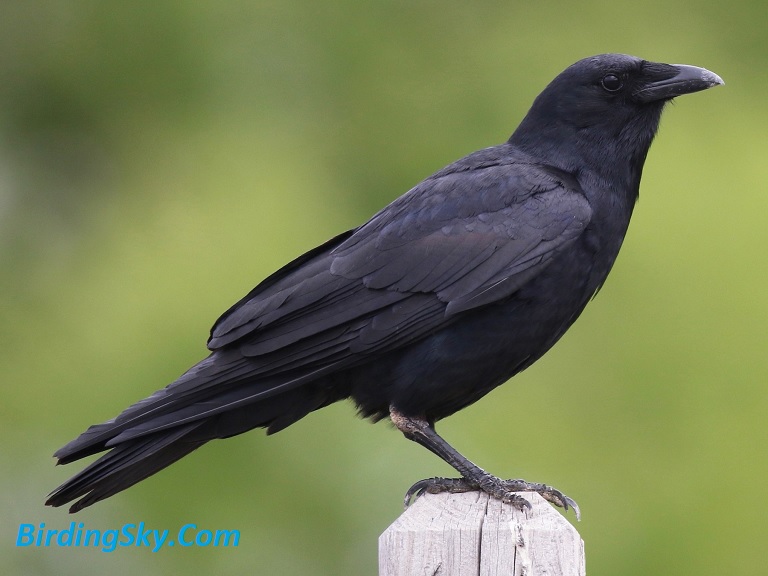
Scientific Name: Corvus ossifragus
- Size: 14-16 inches
- Weight: 8-14 ounces
- Wingspan: 30-33 inches
- Lifespan: 6-8 years
- Habitat: Coastal areas, wetlands, and forests
- Location: Florida’s coastal regions
The Fish Crow is a close relative of the American Crow but is specifically adapted to coastal environments. Their distinctive calls can be heard along Florida’s shorelines as they forage for food.
Fun Fact:
Fish Crows are known for their tool-using abilities. They have been observed using sticks and leaves to extract insects from tree bark.
10. SMOOTH-BILLED ANI
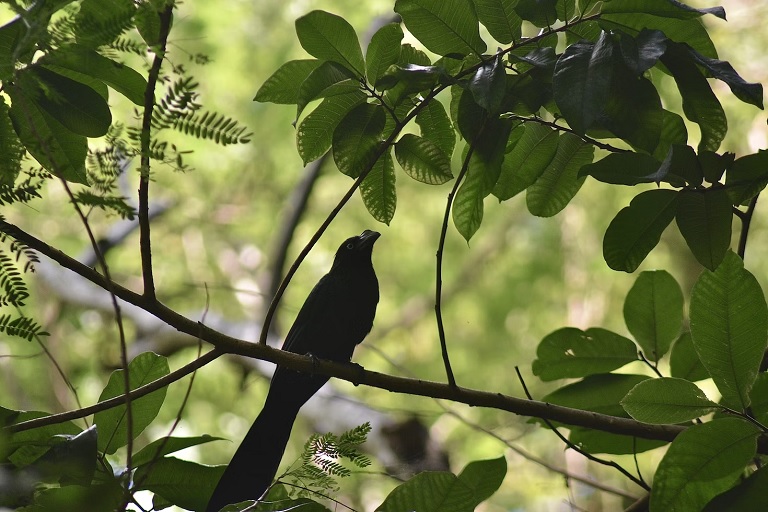
Scientific Name: Crotophaga ani
- Size: 12-14 inches
- Weight: 3.2-3.7 ounces
- Wingspan: 15-17 inches
- Lifespan: 4-5 years
- Habitat: Grasslands, scrublands, and agricultural areas
- Location: Southern Florida
The Smooth-billed Ani is a unique black bird known for its cooperative breeding behavior. These birds often form communal nesting colonies, where multiple pairs help raise each other’s young.
Fun Fact:
Smooth-billed Anis are highly vocal and have a repertoire of various calls, making them excellent communicators within their colonies.
11. EASTERN KINGBIRD
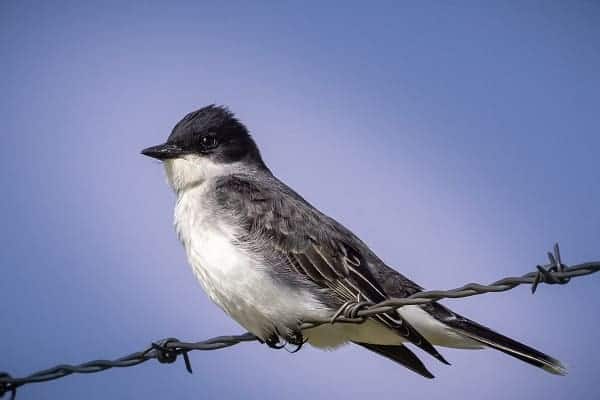
Scientific Name: Tyrannus tyrannus
- Size: 7-9 inches
- Weight: 1.1-1.8 ounces
- Wingspan: 12-15 inches
- Lifespan: 3-4 years
- Habitat: Open woodlands, grasslands, and farmlands
- Location: Throughout Florida
The Eastern Kingbird may be small in size, but it makes up for it with its feisty nature. These birds are known for their bold defense of their nesting territory, often chasing away much larger birds.
Fun Fact:
Eastern Kingbirds are insectivores and are excellent at catching flying insects in mid-air. They are also known to eat berries during the winter months when insects are scarce.
12. BOBOLINK
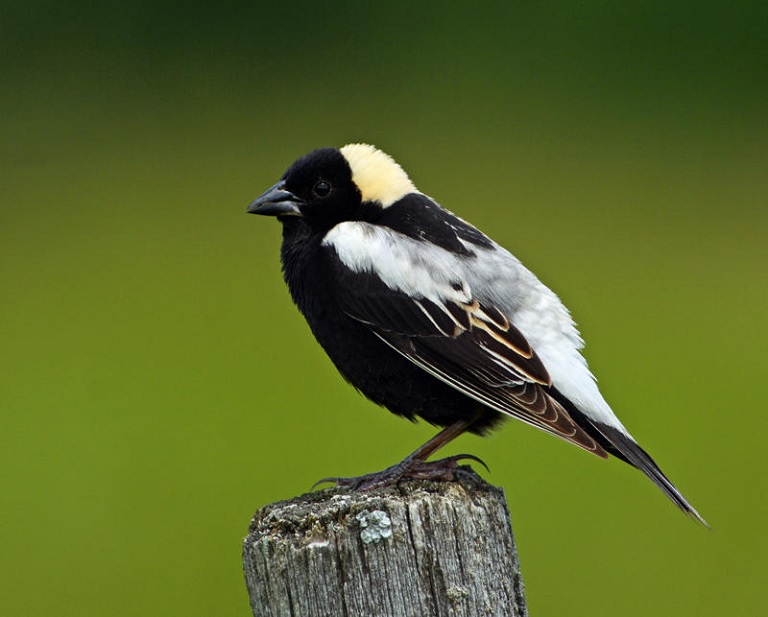
Scientific Name: Dolichonyx oryzivorus
- Size: 6.5-7.5 inches
- Weight: 1.1-2.0 ounces
- Wingspan: 11-12 inches
- Lifespan: 4-6 years
- Habitat: Grasslands, meadows, and agricultural fields
- Location: Northern and Central Florida
The Bobolink is a striking bird with unique black-and-white plumage. During the breeding season, males display a dazzling transformation from black to white, earning them the nickname “skunk blackbird.”
Fun Fact:
Bobolinks undertake one of the longest migrations of any North American songbird, traveling from their breeding grounds in North America to their wintering grounds in South America.
13. RED-WINGED BLACKBIRD

Scientific Name: Agelaius phoeniceus
- Size: 7-9 inches
- Weight: 1.3-2.0 ounces
- Wingspan: 12-15 inches
- Lifespan: 2-3 years
- Habitat: Marshes, wetlands, and grasslands
- Location: Throughout Florida
The Red-winged Blackbird is a familiar sight in Florida’s wetlands, known for its striking red and yellow shoulder patches. Males use their vibrant plumage to attract mates and establish territories.
Fun Fact:
Red-winged Blackbirds are highly territorial and will fiercely defend their nesting sites, often mobbing much larger birds or even humans that approach too closely.
14. BROWN-HEADED COWBIRD
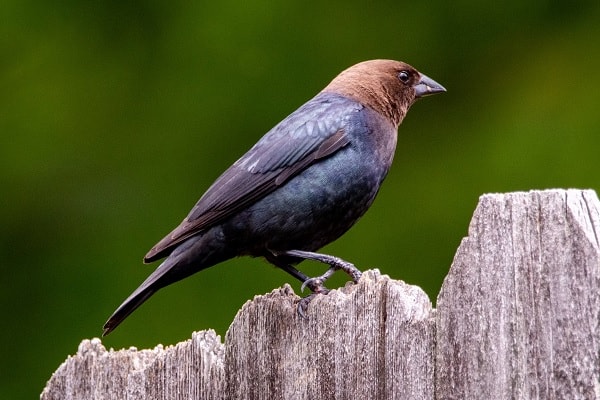
Scientific Name: Molothrus ater
- Size: 7.5-8.5 inches
- Weight: 1.2-2.1 ounces
- Wingspan: 13-15 inches
- Lifespan: 2-3 years
- Habitat: Varied, including grasslands, woodlands, and farmlands
- Location: Throughout Florida
The Brown-headed Cowbird is known for its unique reproductive strategy. These birds are “brood parasites,” laying their eggs in the nests of other bird species and relying on the host birds to raise their young. Their distinctive brown heads make them easily recognizable.
Fun Fact: Brown-headed Cowbirds were historically associated with bison herds, following them to feed on insects stirred up by the large mammals. Today, they have adapted to living near cattle.
15. SHINY COWBIRD
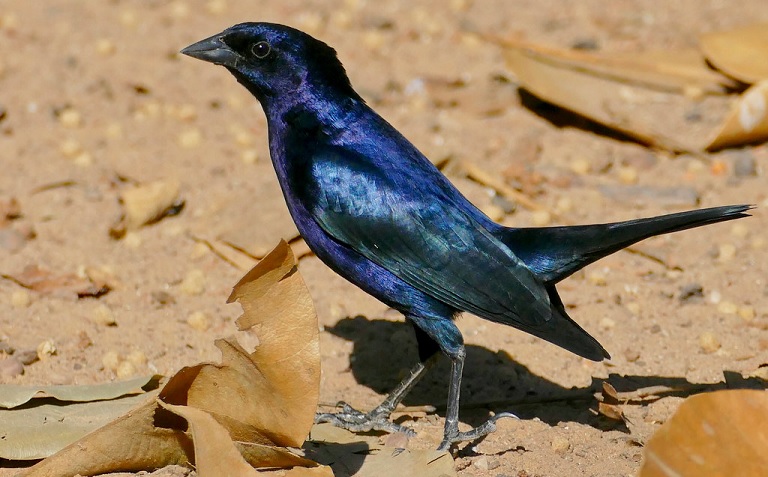
Scientific Name: Molothrus bonariensis
- Size: 6.5-7.5 inches
- Weight: 1.1-1.9 ounces
- Wingspan: 11-12 inches
- Lifespan: 2-3 years
- Habitat: Open woodlands, grasslands, and agricultural areas
- Location: South and Central Florida
The Shiny Cowbird, with its glossy black plumage, is native to South America but has established populations in South and Central Florida. Like the Brown-headed Cowbird, they are brood parasites, laying their eggs in the nests of other bird species.
Fun Fact: Shiny Cowbirds are known for their iridescent plumage, which shimmers in the sunlight, giving them a truly “shiny” appearance.
16. RUSTY BLACKBIRD
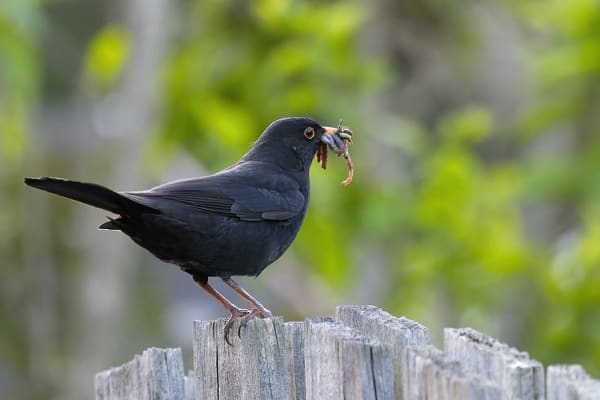
Scientific Name: Euphagus carolinus
- Size: 7-8 inches
- Weight: 1.5-2.2 ounces
- Wingspan: 12-13 inches
- Lifespan: 2-3 years
- Habitat: Swamps, wet woodlands, and forested areas
- Location: Northern Florida and during migration
The Rusty Blackbird is a rare winter visitor to Florida, primarily found in the northern part of the state during the colder months. These birds have dark plumage with rusty feather edges, giving them their name.
Fun Fact: Rusty Blackbirds are known for their preference for wet habitats and are often found foraging in shallow water for insects and aquatic invertebrates.
17. BREWER’S BLACKBIRD
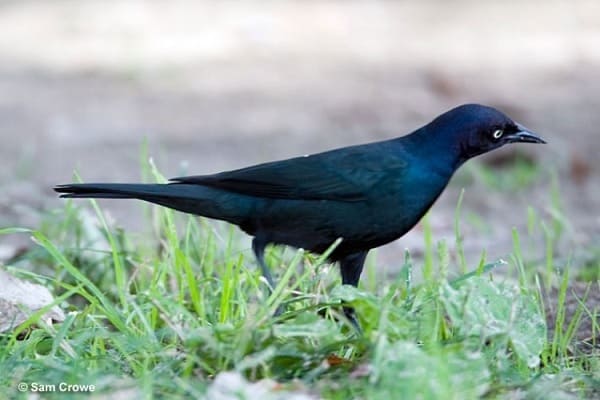
Scientific Name: Euphagus cyanocephalus
- Size: 7.5-9 inches
- Weight: 1.6-2.7 ounces
- Wingspan: 12-14 inches
- Lifespan: Up to 7 years
- Habitat: Varied, including grasslands, agricultural areas, and urban environments
- Location: Rarely in northern Florida during migration
Brewer’s Blackbirds are primarily found in western North America but occasionally appear in northern Florida during migration. They have black plumage with a glossy purple or blue sheen on their heads.
Fun Fact: These birds are highly social and are often seen foraging in flocks, especially in open fields and urban areas.
18. COMMON GRACKLE
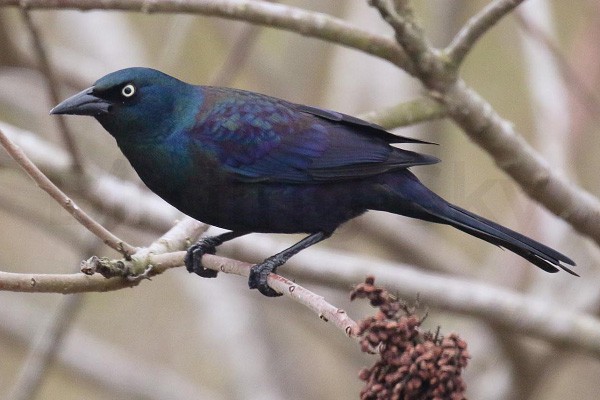
Scientific Name: Quiscalus quiscula
- Size: 11-13 inches
- Weight: 2.6-5.6 ounces
- Wingspan: 14-18 inches
- Lifespan: Up to 5 years
- Habitat: Varied, including woodlands, urban areas, and agricultural fields
- Location: Throughout Florida
The Common Grackle is known for its iridescent black plumage and striking yellow eyes. These birds are highly adaptable and can thrive in a range of environments, including suburban areas.
Fun Fact: Common Grackles are omnivorous and have a varied diet, including seeds, insects, and even small vertebrates.
19. BOAT-TAILED GRACKLE
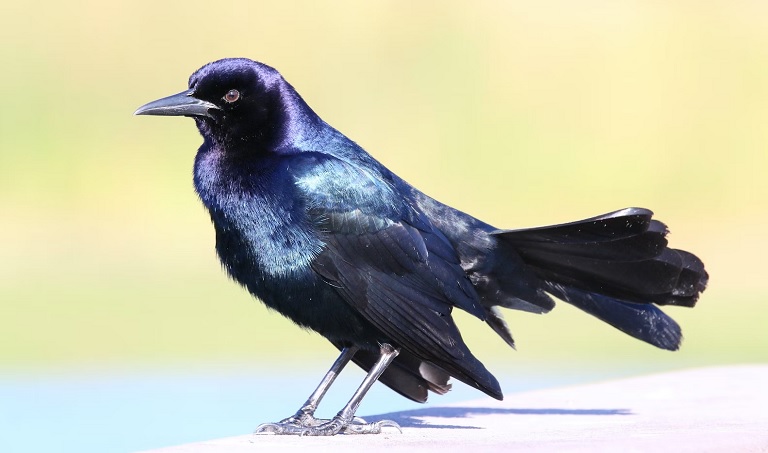
Scientific Name: Quiscalus major
- Size: 12-15 inches
- Weight: 3-5.4 ounces
- Wingspan: 15-24 inches
- Lifespan: 2-4 years
- Habitat: Coastal marshes, wetlands, and grasslands
- Location: Coastal areas of Florida
The Boat-tailed Grackle is a distinctive bird with a long, keel-shaped tail, which resembles the keel of a boat. These grackles are commonly found in Florida’s coastal marshes.
Fun Fact: Boat-tailed Grackles are known for their loud and melodious calls, which are often heard in their coastal habitats.
20. EUROPEAN STARLING
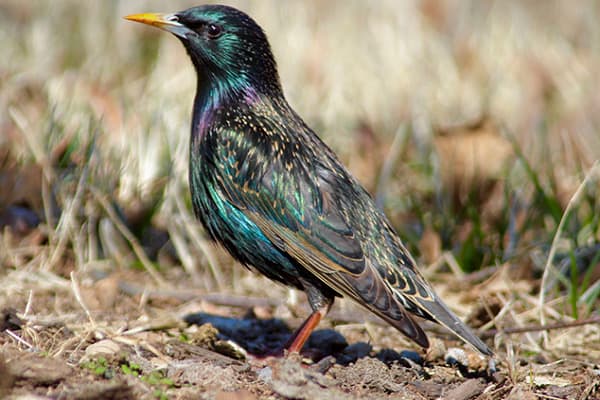
Scientific Name: Sturnus vulgaris
- Size: 7-9 inches
- Weight: 2-3 ounces
- Wingspan: 12-17 inches
- Lifespan: Up to 15 years
- Habitat: Varied, including woodlands, urban areas, and agricultural fields
- Location: Throughout Florida
The European Starling, while not native to North America, has become a common sight in Florida and across the continent. These birds are known for their iridescent black plumage and their ability to mimic other bird species.
Fun Fact: European Starlings were introduced to North America in the 19th century and have since become one of the continent’s most numerous bird species.
These 20 black birds in Florida offer a glimpse into the fascinating avian diversity found in the Sunshine State. From wetlands to woodlands and coastal areas to urban environments, these birds have adapted to a wide range of habitats, making Florida a birdwatcher’s paradise. Whether you’re a seasoned birder or simply appreciate the beauty of nature, exploring Florida’s avian residents is a rewarding experience that connects you to the natural world. Learn more about birds only on our website BirdingSky.org
Frequently Asked Questions
Q1: What are the loud black birds in Florida?
The loud black birds commonly heard in Florida are likely the Boat-tailed Grackles and Common Grackles. They are known for their distinctive and often noisy calls.
Q2: What is the black bird with a loud cry?
The black bird with a loud cry in Florida could be the Common Grackle. They are known for their loud and raucous calls.
Q3: What bird makes a weird noise at night in Florida?
The bird that makes unusual or eerie noises at night in Florida may be the Eastern Whip-poor-will, known for its repetitive and haunting call that sounds like it’s saying “whip-poor-will.”
Q4: What is the loud screaming bird in Florida?
The loud screaming bird in Florida could be the Red-shouldered Hawk, which produces a distinctive and piercing scream-like call.
Q5: What is the Florida bird with many sounds?
The Northern Mockingbird is a Florida bird known for its impressive ability to mimic a wide variety of sounds, including the songs of other birds and even mechanical noises.
